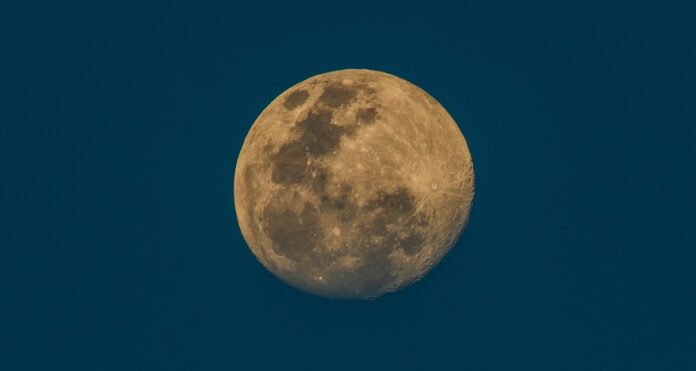One of the most beautiful things about mother Earth is presence of an atmosphere. Life on Earth would not have been possible without the lively sheet of air that completely embraces Earth from all around. In the early phase of evolution of the atmosphere in the geologic times, chemical reactions within the Earth’s crust were the critical source of gasses. However, with the evolution of life, the biochemical processes associated with life took over and maintain the current gaseous balance. Thanks to the flow of molten metals in the Earth’s interior that give rise to Earth’s magnetic field responsible for deflection of most of the ionising solar winds (continuous stream of electrically charged particles viz. plasma originating from the solar atmosphere) away from the Earth. The uppermost layer of atmosphere absorbs the remaining ionising radiation, in turn becoming ionised (hence called ionosphere).
Does the Moon, the natural satellite of Earth, have an atmosphere?
The Moon does not have an atmosphere the way we experience it on Earth. Its gravitational field is weaker than Earth’s; while escape velocity at Earth’s surface is about 11.2 km/sec (air resistance disregarded), on Moon’s surface it is merely 2.4 km/sec which is much less than the root mean square (RMS) velocity of hydrogen molecules on the Moon. As a result, most of the hydrogen molecules escape to space and the Moon is unable to retain any significant sheet of gases around it. However, this does not mean the Moon has no atmosphere at all. The Moon has an atmosphere but it’s so thin that a near vacuum condition prevails at the Moon’s surface. The Moon’s atmosphere is extremely thin: about 10 trillion times thinner than the Earth’s atmosphere. Density of the Moon’s atmosphere is at par with the density of the outermost fringes of Earth’s atmosphere1. It is in this context that many argue that the Moon has no atmosphere.
The lunar atmosphere is important for the future of mankind. Hence there has been a series of studies over the last 75 years.
NASA’s Appolo Mission made significant contributions when it first detected lunar atmosphere4. Lunar Atmospheric Composition Experiment (LACE) of Apollo 17 found small amounts of a number of atoms and molecules (including helium, argon, and possibly neon, ammonia, methane and carbon dioxide) on the Moon’s surface1. Subsequently, ground based measurements discovered sodium and potassium vapour in the Moon’s atmosphere using emission line spectroscopy2. There were also reports on the finding of metal ions emanating from the Moon in interplanetary space and H2O ice at the polar region of the Moon3.
For the last 3 Ga (1 Ga or giga-annum = 1 billion years or 109 years), the Moon’s atmosphere is stable with low-density surface boundary exosphere (SBE). Prior to that, the Moon had a more prominent, albeit transient atmosphere due to substantial volcanic activity on the Moon4.
Recently published studies using measurements from ISRO‘s lunar orbiter reveal that the ionosphere of the Moon can have a very high electron density. The lunar surface electron density could be as high as 1.2 × 105 per cubic cm but the solar wind acts as a strong removal agent sweeping all the plasma to the interplanetary medium5. The interesting finding however was the observation of the high electron content in the wake region (region of trailing disturbances in the solar wind in the anti-sunward direction). It was larger than in the dayside direction given the fact that neither the solar radiation nor the solar wind interacts directly with the available neutral particles in this region6. The study shows that the dominant ions in the wake region are Ar+, and Ne+ which have a comparatively longer lifetime than the molecular ions (CO2+, and H2O+ ) that are dominant in other regions. Because of their higher lifetime, the Ar+ and Ne+ ions survive in the wake region while the molecular ions recombine and disappear. High electron density was found also near lunar polar regions during solar transition periods5,6.
NASA’s planned Artemis Mission to the Moon aims to set up Artemis Base Camp on the lunar surface and the Gateway in lunar orbit. This will certainly help more detailed and direct study of the lunar atmosphere7.
***
References:
- NASA 2013. Is There an Atmosphere on the Moon? Available online at https://www.nasa.gov/mission_pages/LADEE/news/lunar-atmosphere.html#:~:text=Just%20as%20the%20discovery%20of,of%20Earth%2C%20Mars%20or%20Venus.
- Potter AE and Morgan TH 1988. Discovery of Sodium and Potassium Vapor in the Atmosphere of the Moon. SCIENCE 5 Aug 1988 Vol 241, Issue 4866 pp. 675-680. DOI: https://doi.org/10.1126/science.241.4866.67
- Stern SA 1999. The lunar atmosphere: History, status, current problems, and context. Reviews of Geophysics. First published: 01 November 1999. Volume37, Issue 4 November 1999. Pages 453-491. DOI: https://doi.org/10.1029/1999RG900005
- Needham DH and Kringab DA 2017. Lunar volcanism produced a transient atmosphere around the ancient Moon. Earth and Planetary Science Letters. Volume 478, 15 November 2017, Pages 175-178. DOI: https://doi.org/10.1016/j.epsl.2017.09.002
- Ambili KM and Choudhary RK 2021. Three-dimensional distribution of ions and electrons in the lunar ionosphere originated from the photochemical reactions. Monthly Notices of the Royal Astronomical Society, Volume 510, Issue 3, March 2022, Pages 3291–3300, DOI: https://doi.org/10.1093/mnras/stab3734
- Tripathi KR, et al 2022. A study on the characteristic features of the lunar ionosphere using dual frequency radio science (DFRS) experiment onboard Chandrayaan-2 orbiter. Monthly Notices of the Royal Astronomical Society: Letters, Volume 515, Issue 1, September 2022, Pages L61–L66, DOI: https://doi.org/10.1093/mnrasl/slac058
- NASA 2022. Artemis Mission. Available at https://www.nasa.gov/specials/artemis/
***






































